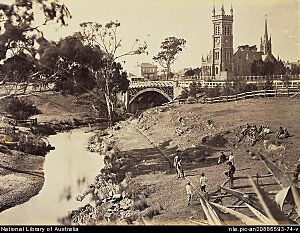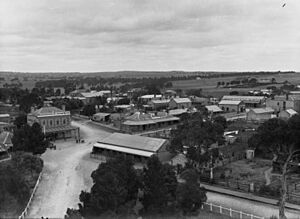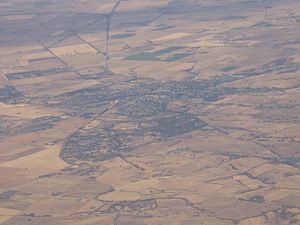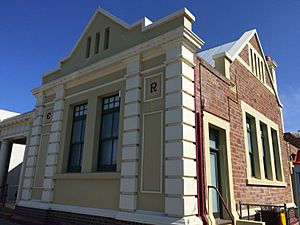Strathalbyn, South Australia facts for kids
Quick facts for kids StrathalbynSouth Australia |
|||||||||||||||
|---|---|---|---|---|---|---|---|---|---|---|---|---|---|---|---|
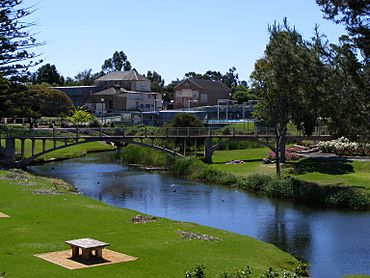
River Angas in Strathalbyn
|
|||||||||||||||
| Population | 6,504 (2016 census) | ||||||||||||||
| Established | 1839 | ||||||||||||||
| Postcode(s) | 5255 | ||||||||||||||
| Location | 60 km (37 mi) from Adelaide | ||||||||||||||
| LGA(s) | Alexandrina Council | ||||||||||||||
| Region | Fleurieu and Kangaroo Island | ||||||||||||||
| Federal Division(s) | Mayo | ||||||||||||||
|
|||||||||||||||
Strathalbyn is a lovely town located in South Australia. It's part of the Alexandrina Council area. In 2016, about 6,500 people lived here.
Contents
Where is Strathalbyn Located?
Strathalbyn is about 60 kilometers (37 miles) southeast of Adelaide. It sits right next to the River Angas. The town is on the edge of the Adelaide Hills and marks the start of the beautiful Fleurieu Peninsula.
What is Strathalbyn's Climate Like?
Strathalbyn has a climate known as a warm-summer mediterranean climate. This means it usually has warm, dry summers and mild, wet winters.
Discovering Strathalbyn's Past
Long before European settlers arrived, Aboriginal Australians lived in the area where Strathalbyn is now. These included groups known today as the Ngarrindjeri people. They lived across the Fleurieu Peninsula, the lower Murray River, and the Coorong regions.
The town of Strathalbyn was officially started in 1839. The first people to own land here were Dr. Rankine and Donald McLean. In 1846, the area became known as the Hundred of Strathalbyn.
Strathalbyn was once a very important stop. It was on the main travel route between Adelaide and Melbourne. The town was planned with wide streets and large areas set aside for parks along the River Angas. Many early settlers were from Scotland, and the town quickly became a center for farming and raising animals. Later, mining also became important.
How Did Strathalbyn Get Its Railway?
Strathalbyn was connected to Goolwa and Victor Harbor by a horse tram line starting in 1869. This was a special type of railway where horses pulled the trams. Later, in 1884, the line was upgraded for steam engines and extended to Mount Barker and Adelaide.
In 1995, the railway line was changed to a different size, which meant Strathalbyn's line was no longer connected to the main Adelaide-Melbourne railway line. Today, a historic tourist train called SteamRanger still runs on this old line, making stops in Strathalbyn.
What is Strathalbyn's Economy?
Mining in Strathalbyn
In the late 1800s, small mines for lead, zinc, gold, and copper operated near Strathalbyn. These mines were not very big and closed a long time ago.
More recently, in 2008, a company called Terramin Australia Ltd opened an underground zinc mine. This mine brought about $29 million into the local economy and created around 100 jobs. It was expected to produce zinc and lead, along with small amounts of silver, gold, and copper, for about seven years.
However, the mine stopped working in October 2013. This was because metal prices were low, and they had mined most of the valuable ore. Over 100 jobs were lost when the mine closed. There's a chance the zinc mine might reopen in the future if metal prices go up again.
What Fun Things Can You Do in Strathalbyn?
Strathalbyn has four pubs in the town center: The Victoria, The Robin Hood, The Terminus, and the Commercial. The town hosts an annual fair for collectors, hobbies, and antiques every August. Other popular events include the Strathalbyn Rotary Club's famous Duck Race, the Strathalbyn Show, and the Street Parade with Carols by Candlelight. There's also a Sunday market once a month at Gilbert’s Motor Museum.
In 1975, parts of the movie Picnic at Hanging Rock were filmed on the streets of Strathalbyn. The Children's Bridge is a special pedestrian bridge over the river in the town park.
Strathalbyn's Historic Buildings
The Strathalbyn Post Office is a very important building. It was added to the Commonwealth Heritage List in 2004. Built between 1911 and 1912, it shows how the town grew over time. The building is a mix of Edwardian Baroque and Arts and Crafts styles, which was a popular design for public buildings at the time.
Antiques in Strathalbyn
Strathalbyn is well-known for its many antique shops, especially along its main street. London House is one of the oldest and most famous antique shops there.



